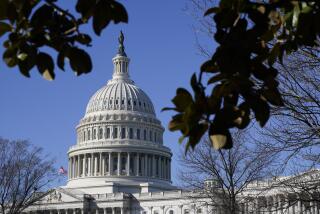Rivals Also Split on Ad Strategy
- Share via
WASHINGTON — While President Bush goes national in his television advertising, Sen. John F. Kerry is thinking local.
According to political ad data compiled Monday for The Times, the Republican incumbent has spent far more this year on TV advertisements for national cable channels. By contrast, the Democratic challenger has spent more than Bush recently on ads scripted for local broadcast in particular states.
Analysts said the national cable ads helped Bush project a uniform message throughout the 50 states and influence news coverage nationwide. But the state-specific ads, they said, helped Kerry connect with TV viewers who had been bombarded by political commercials in places such as Philadelphia and Miami.
Kerry’s strategy “has an opportunity to get through the clutter and speak specifically to the voter,” said Evan Tracey, chief operating officer of TNSMI/Campaign Media Analysis Group, which tracks ads for The Times.
Bush, he said, was seeking through his national ad buying to show that issues such as terrorism “affect us all.”
Last week, Bush and the Republican National Committee spent more than $15 million on TV ads on cable and in the 100 largest broadcast markets, according to the ad monitor.
Kerry and the Democratic National Committee spent more than $21 million from Oct. 3 through Saturday.
Outside groups spent millions more. The Media Fund, a pro-Democratic organization, spent more than $600,000 on ads critical of Bush’s record on jobs and education in Ohio. The New Democrat Network spent more than $300,000 on Spanish-language ads to boost the Democratic Party, including two tailored to Cuban Americans in Miami.
On the other side, the Progress for America Voter Fund, a pro-Republican group, spent more than $1.1 million on ads criticizing Kerry on national security. They ran in Iowa, Wisconsin, New Mexico, Minnesota and on national cable channels.
The Swift Boat Vets and POWs for Truth (formerly Swift Boat Veterans for Truth) spent about $600,000 to criticize Kerry’s Vietnam War-era protests on cable TV and broadcasts in Ohio, Pennsylvania and Nevada.
Among cable outlets, which have gained audience share in recent years, Bush and the GOP last week were on CNN, Fox News Channel, MSNBC, the History Channel, the Learning Channel, Country Music Television and TNT-- with ad buys totaling more than $425,000. Kerry had no national cable ads last week, according to the ad monitor, and the Democratic Party spent $240,000 on cable TV.
Those figures continue a yearlong trend. Since March, Bush and the GOP have spent about $11.5 million on cable TV; Kerry and the Democratic Party have spent less than $5 million.
Tracey said the cable ads enabled Bush to target demographic groups -- such as “security moms” and “NASCAR dads” -- and core party followers.
TV testimonials for Kerry popped up last week in several key markets, each delivered by local personalities.
In Albuquerque, a retired New Mexico Army National Guard major general named Mel Montano defended Kerry’s Vietnam War record in a 30-second spot. In Pennsylvania, Kerry enlisted two prominent Democrats to appear in separate ads for him: Gov. Ed Rendell and Bob Casey Jr., son of a former governor. Rendell’s ad appeared in Philadelphia and Casey’s in Wilkes-Barre.
In Miami, Tampa and Orlando, Fla., Sen. Bob Graham (D-Fla.) was featured in an ad that attacked Bush and extolled Kerry. Sen. Robert C. Byrd, a Democratic icon in West Virginia, played the same role on air in Charleston, W.Va.
“George Bush is no friend to West Virginia, believe me,” Byrd says in the ad. “At the Bush White House, the working man is the forgotten man.”
By contrast, the Bush ads in Charleston last week were no different than ads seen in several other states -- attacking Kerry as weak on national security, prone to raise taxes and against legal liability limits.
The Bush campaign declined to discuss its ad strategy Monday.
Kerry strategist Tad Devine said: “The races in different states are unique, and we want to tailor our messages to voters who live in different places and are concerned about different issues.”
More to Read
Get the L.A. Times Politics newsletter
Deeply reported insights into legislation, politics and policy from Sacramento, Washington and beyond. In your inbox twice per week.
You may occasionally receive promotional content from the Los Angeles Times.










